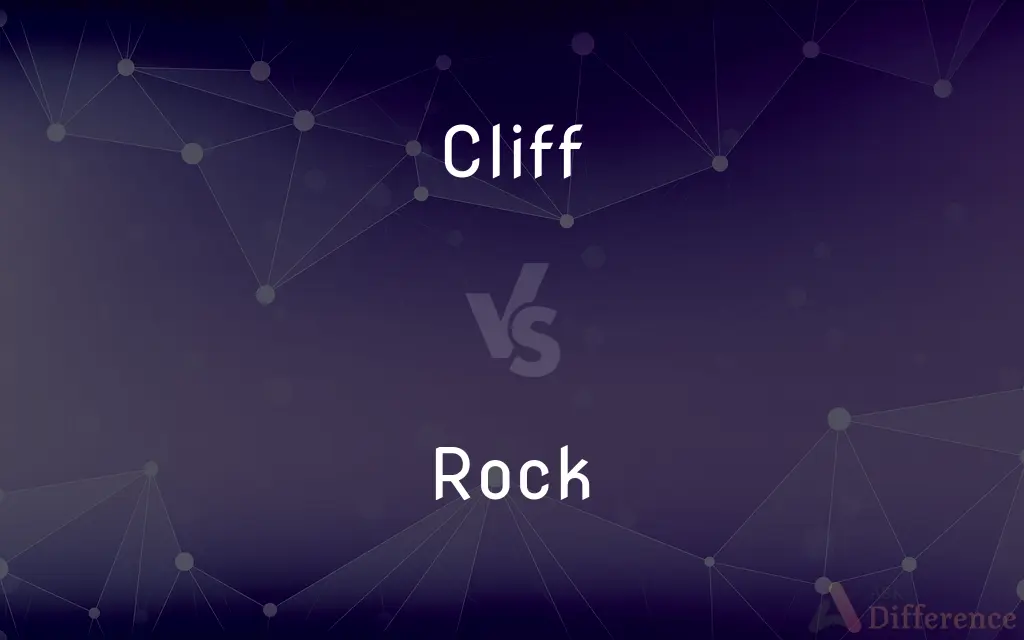Cliff vs. Rock — What's the Difference?
By Urooj Arif & Fiza Rafique — Updated on March 2, 2024
A cliff is a steep, high face of rock or earth, often overlooking a sea or other body of water, while a rock is a solid mineral material forming part of the surface of the earth and other similar planets, used in various forms and sizes in nature.

Difference Between Cliff and Rock
Table of Contents
ADVERTISEMENT
Key Differences
A cliff represents a specific geological formation, characterized by its significant height, steepness, and often dramatic landscapes. Cliffs are formed through processes such as erosion and the weathering of rock or earth materials, leading to their precipitous nature. They are notable features in both coastal and inland regions, serving as prominent landmarks and ecosystems for various flora and fauna. On the other hand, a rock is a more general term that refers to any natural solid mineral material. Rocks can vary greatly in size, from small pebbles to massive mountain ranges, and they compose the majority of the Earth's crust. Rocks are classified into three main types based on their formation: igneous, sedimentary, and metamorphic, each with distinct characteristics and formation processes.
While cliffs are essentially made up of rock or earth materials, not all rocks form cliffs. The formation of a cliff depends on specific environmental conditions and processes that cause the vertical or near-vertical exposure of rock faces. In contrast, rocks are fundamental components of the Earth’s surface and can be found in various environments, from riverbeds to deserts and from mountain peaks to ocean floors.
The study and exploration of cliffs can offer insights into the Earth's history, including information about past climates, sea levels, and geological events. Climbers and adventurers often seek out cliffs for recreation and challenge, highlighting their cultural and recreational significance. Conversely, rocks are studied in the field of geology to understand the Earth's composition, structure, and the processes that have shaped it over time. Rocks are also utilized by humans in construction, manufacturing, and art, underscoring their practical importance.
Cliffs can provide unique habitats that support specialized plant and animal life, adapted to the harsh, often inaccessible environments. Rocks, depending on their location and formation, contribute to the foundation of various ecosystems, offering shelter and resources for a wide range of organisms.
The aesthetic and symbolic significance of cliffs and rocks also varies; cliffs often symbolize challenge, beauty, and the sublime in nature, featuring prominently in art and literature. Rocks, with their diverse shapes, colors, and textures, have been used by humans for millennia for artistic expression, spiritual practices, and as symbols of strength and endurance.
ADVERTISEMENT
Comparison Chart
Definition
A steep, high face of rock or earth
A solid mineral material
Formation
Erosion, weathering of materials
Cooling of magma, sedimentation, metamorphism
Size and Scope
Large, specific landscape features
Varies greatly, from pebbles to mountains
Types
Coastal, inland cliffs
Igneous, sedimentary, metamorphic
Significance
Landmarks, ecosystems, recreation
Earth’s composition, construction, art
Habitat
Unique flora and fauna
Foundation for diverse ecosystems
Human Use
Adventure, study
Construction, manufacturing, art
Symbolism
Challenge, beauty
Strength, endurance
Compare with Definitions
Cliff
Steep rock face, often by water.
The White Cliffs of Dover are iconic for their chalk composition and historical significance.
Rock
Classified by formation.
Limestone is a sedimentary rock formed from marine organisms.
Cliff
Symbol of natural beauty.
Cliffs in national parks are major tourist attractions.
Rock
Used in construction.
Marble, a metamorphic rock, is prized for its beauty in sculpture and architecture.
Cliff
Habitat for unique species.
Peregrine falcons often nest on inaccessible cliff ledges.
Rock
Found everywhere on Earth.
Sedimentary rocks cover much of the Earth's surface.
Cliff
Subject of adventure.
Rock climbers seek the challenge of scaling vertical cliffs.
Rock
Solid mineral matter.
Granite is a durable igneous rock used in construction.
Cliff
Formed by erosion.
Coastal cliffs erode under the force of ocean waves.
Rock
Symbolizes durability.
Rocks are often used to symbolize strength in monuments and memorials.
Cliff
In geography and geology, a cliff is an area of rock which has a general angle defined by the vertical, or nearly vertical. Cliffs are formed by the processes of weathering and erosion, with the effect of gravity.
Rock
The solid mineral material forming part of the surface of the earth and other similar planets, exposed on the surface or underlying the soil
A piece of rock
A spectacular rock arch
The beds of rock are slightly tilted
Cliff
A steep rock face, especially at the edge of the sea
A coast path along the top of rugged cliffs
Rock
A large piece of rock which has become detached from a cliff or mountain; a boulder
The stream flowed through a jumble of rocks
Cliff
A high, steep, or overhanging face of rock.
Rock
Used to refer to someone or something that is extremely strong, reliable, or hard
The Irish scrum has been as solid as a rock
Cliff
A steep high face of rock;
He stood on a high cliff overlooking the town
A steep drop
Rock
Cause to move back and forth;
Rock the cradle
Rock the baby
The wind swayed the trees gently
Common Curiosities
How are cliffs and rocks related?
Cliffs are geological formations made up of rock or earth materials, representing a specific type of landscape feature formed from rocks.
What is a cliff?
A cliff is a steep, high rock face, often formed by the processes of erosion and weathering, that creates a significant vertical or near-vertical drop.
What is a rock?
A rock is a natural solid material composed of one or more minerals, forming a significant part of the Earth's crust and surface.
Why are cliffs important for ecosystems?
Cliffs provide unique habitats that support specialized species adapted to the challenging conditions, contributing to biodiversity.
What are the different types of rocks?
Rocks are classified into three main types: igneous (formed from cooled magma or lava), sedimentary (formed from accumulated sediments), and metamorphic (formed from existing rocks transformed by heat and pressure).
Are all cliffs located by the sea?
No, cliffs can be coastal or inland, formed by different processes such as river erosion, glacial activity, or the uplift of the earth's crust.
Can any rock form a cliff?
While many types of rock can form cliffs, the specific conditions of erosion and weathering that create cliffs depend on the location, type of rock, and environmental factors.
How do humans use rocks?
Humans use rocks in a variety of ways, including for construction, manufacturing, art, and as tools, due to their diverse physical properties.
What makes cliffs significant in culture and recreation?
Cliffs are often seen as symbols of challenge and beauty, attracting adventurers, artists, and tourists for their dramatic landscapes and the opportunities for exploration they offer.
How do rocks contribute to the Earth's surface?
Rocks make up the majority of the Earth's crust, shaping the planet's surface, influencing landscapes, and providing the foundation for soil and various ecosystems.
Share Your Discovery

Previous Comparison
Thumbnail vs. Thumbtack
Next Comparison
Haze vs. DazeAuthor Spotlight
Written by
Urooj ArifUrooj is a skilled content writer at Ask Difference, known for her exceptional ability to simplify complex topics into engaging and informative content. With a passion for research and a flair for clear, concise writing, she consistently delivers articles that resonate with our diverse audience.
Co-written by
Fiza RafiqueFiza Rafique is a skilled content writer at AskDifference.com, where she meticulously refines and enhances written pieces. Drawing from her vast editorial expertise, Fiza ensures clarity, accuracy, and precision in every article. Passionate about language, she continually seeks to elevate the quality of content for readers worldwide.














































